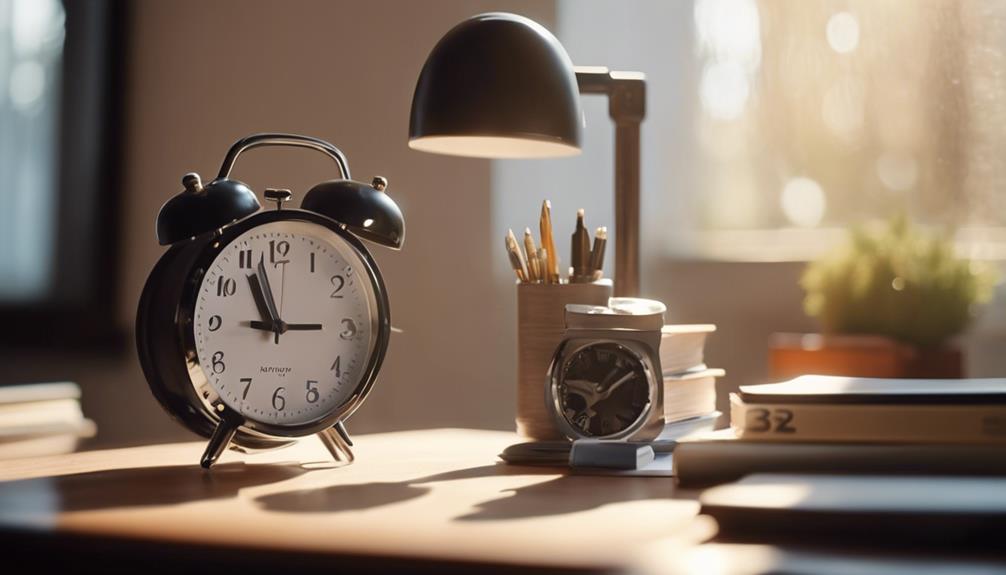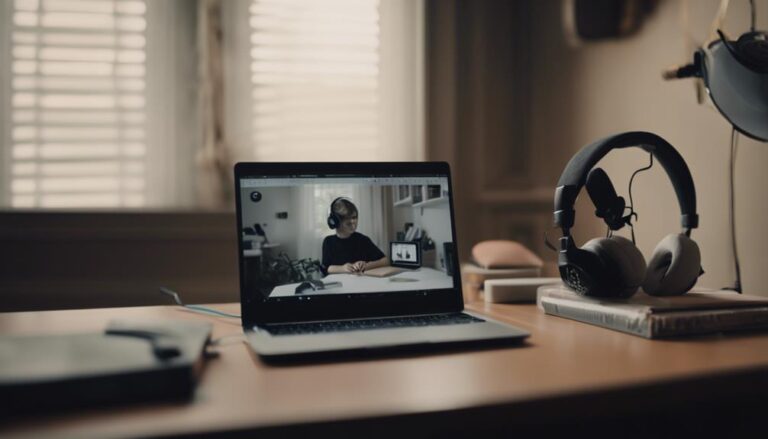I've mastered balancing work and home life using these top ten tips. I start my day with a morning routine, separating my personal time from work. I've got an organized, ergonomic workspace that boosts my focus. Strict work hours help prevent burnout, and regular breaks keep me energized. I focus on one task at a time to stay productive. Digital detoxes are part of my strategy to unwind. Clear communication of boundaries guarantees respect for my personal time. Prioritizing self-care, like exercise and mindfulness, keeps me balanced. Support from family, friends, and colleagues is essential. Discover more on enhancing your work-home balance!
Key Takeaways
- Establish a morning routine to separate personal time from work, enhancing mental clarity.
- Create an organized, ergonomic workspace to boost productivity and comfort.
- Define specific work hours to prevent overworking and maintain boundaries.
- Take regular short breaks to maintain focus and prevent burnout.
- Engage in post-work relaxation activities to unwind and reduce stress.
Establish a Morning Routine
Starting my day with activities I love sets a positive tone and helps reduce work-related stress. By establishing a morning routine filled with enjoyable non-work activities, I create a buffer that separates my personal time from work.
This practice is essential for setting boundaries, preventing burnout, and maintaining mental health. I avoid checking work emails from bed and instead focus on activities like reading, exercising, or enjoying a nutritious breakfast. These moments of self-care energize me and prepare my mind for a productive day.
Embracing a morning routine not only boosts my well-being but also enhances my ability to innovate and stay motivated throughout the workday.
Create a Dedicated Workspace
Creating a dedicated workspace has been a game-changer for me.
I chose ergonomic furniture to stay comfortable and minimize distractions, which has greatly boosted my productivity.
Keeping my work area organized and clutter-free helps me stay focused and motivated throughout the day.
Choose Ergonomic Furniture
Investing in ergonomic furniture is one of the smartest decisions you can make to create a dedicated and productive workspace at home. An ergonomic office chair, for instance, supports proper posture and reduces the risk of musculoskeletal issues, directly enhancing your work-life balance.
Adjustable chairs and desks cater to individual comfort, ensuring that you remain focused and productive throughout the day. By creating a workstation designed for well-being, you're not just minimizing discomfort—you're also boosting your overall health and work performance.
Imagine the difference a well-designed workspace can make: increased focus, fewer aches, and a harmonious balance between work and home life. So, don't hesitate to invest in ergonomic furniture; your body and mind will thank you.
Minimize Distractions Consistently
Designating a specific area in your home as a dedicated workspace can significantly minimize distractions and boost your productivity. By keeping this area clutter-free and organized, you can create an environment that fosters focus and efficiency.
I find that using noise-canceling headphones or playing soft background music helps block out external distractions. Setting clear boundaries with family members or roommates is essential; they need to understand and respect your workspace and work hours.
Additionally, sticking to a structured daily routine can help establish a clear separation between work time and personal time. Embracing these strategies not only enhances productivity but also contributes to a healthier work-home balance, making it easier to innovate and excel in your endeavors.
Set Clear Work Hours

When I set clear work hours, I find it much easier to balance my professional and personal life. By defining my start and end times, I guarantee that work doesn't spill over into my personal time, and communicating my availability helps others respect my boundaries.
This approach not only boosts my productivity but also reduces stress, making my day more manageable and fulfilling.
Define Start and End
Setting clear work hours is essential for maintaining a healthy work-life balance. By defining start and end times, I can create boundaries that boost my time management skills and enhance productivity.
Having specific work hours means I'm laser-focused during work periods, which prevents overworking and burnout. It's all about innovating the way I approach my daily schedule.
When I know exactly when my workday starts and ends, I can switch off from work mode and fully enjoy my personal time. This balance not only improves my efficiency but also revitalizes my energy, ensuring I'm at my best both professionally and personally.
Communicate Availability Clearly
I always make it a point to clearly communicate my work hours to guarantee everyone respects my boundaries and expectations. By setting clear work hours, I establish a consistent schedule that helps me maintain a healthy work-life balance.
Communicating availability assures my colleagues and family know when I'm focused on work and when I'm off-limits. This practice prevents work from encroaching on personal time, allowing me to unwind and recharge.
Setting boundaries this way also means I'm not overcommitting to tasks outside my designated hours. With a clear separation between work and personal time, I experience reduced stress and improved overall well-being.
This approach fosters innovation and productivity within the structured timeframes I've set.
Take Regular Breaks
Taking regular breaks throughout the workday is essential for maintaining focus, boosting productivity, and enhancing overall well-being. I've found that integrating short breaks every 60-90 minutes into my schedule greatly contributes to a healthier work-home balance. Regular breaks aren't just about pausing work; they're opportunities to recharge and cultivate mindfulness.
By stepping away from my desk, engaging in physical activity, or practicing relaxation techniques, I boost my energy levels and mental clarity. Research supports that these breaks enhance creativity, reduce stress, and prevent burnout. Structured breaks help me return to tasks with renewed concentration and vigor, ultimately fostering a more innovative and balanced work approach.
Avoid Multitasking

I've found that focusing on a single task at a time dramatically boosts my productivity and reduces stress.
By prioritizing daily objectives and scheduling regular break intervals, I can manage my time more effectively and maintain better work-home balance.
Let's commit to tackling one task after another, ensuring each gets our full attention and best effort.
Focus on Single Task
Many people don't realize that focusing on a single task at a time can dramatically boost both productivity and well-being.
When we avoid multitasking, our focus sharpens, and our efficiency skyrockets.
Research shows that juggling too many tasks can reduce productivity by up to 40% and even cause a 10-point drop in IQ.
This means our cognitive performance takes a hit, and stress levels soar.
Prioritize Daily Objectives
By prioritizing daily objectives, we can guarantee that our most important tasks receive the attention they deserve, fostering a more balanced and productive work-home life. Focusing on what truly matters helps us manage our time effectively and avoid the pitfalls of multitasking, which can decrease productivity by up to 40%.
Here's how to prioritize effectively:
- List Tasks by Importance: Identify and rank tasks based on their urgency and impact.
- Set Clear Goals: Define what needs to be achieved by the end of the day.
- Time Block: Allocate specific time slots for each task to ensure focused effort.
- Review and Adjust: Regularly assess priorities and adjust as needed.
Schedule Break Intervals
How often do we find ourselves overwhelmed and exhausted because we haven't taken the time to step away and recharge? Scheduling regular break intervals is essential for maintaining a healthy work-home balance.
By intentionally setting these breaks in our schedule, we allow time for relaxation and rejuvenation, which enhances focus and productivity. Research shows that avoiding multitasking and dedicating our attention to one task at a time can reduce mental fatigue and improve cognitive performance.
When we incorporate these short, frequent breaks, we're making a conscious effort to prevent burnout and stress. Let's embrace this innovative approach to our work routine, ensuring we work more efficiently and make better decisions while feeling refreshed and balanced.
Plan Post-Work Activities
Planning post-work activities can greatly enhance your work-home balance and overall well-being. By intentionally setting aside time to relax after work, you'll find it easier to switch from your professional responsibilities to personal rejuvenation.
Here's how to uplift your evenings with innovative self-care routines:
- Engage in relaxing activities like meditation, reading, or listening to music to unwind.
- Plan outdoor activities such as walks, bike rides, or gardening to decompress after work.
- Schedule time for hobbies like painting, cooking, or crafting to destress and boost creativity.
- Connect with loved ones through phone calls, video chats, or family dinners to nurture relationships.
Practice Digital Detox

Practicing a digital detox can significantly enhance your mental well-being and help you regain control over your work-home balance. By setting boundaries with technology, you can reduce stress and improve your overall mood.
One of my top work-life balance tips is to designate specific times to unplug from screens entirely. This not only prevents burnout but also fosters a healthy work-life balance.
Research demonstrates that excessive screen time leads to anxiety and sleep disturbances, which can negatively impact productivity. Taking regular breaks from devices can enhance relationships, increase focus, and boost creativity.
Embrace the challenge of a digital detox, and you'll likely find yourself sleeping better, feeling happier, and being more innovative in both your personal and professional life.
Communicate Boundaries
Setting clear boundaries with your work hours and availability is essential for maintaining a balanced and fulfilling personal life. I've found that when I communicate boundaries effectively, it greatly improves my work-home balance.
Here are some practical steps:
- Clearly state your work hours: Let colleagues and supervisors know when you're available and when you're offline.
- Set expectations: Communicate your needs for uninterrupted personal time to prevent work from encroaching on your home life.
- Utilize tools: Use out-of-office messages and status updates to signal your availability.
- Be consistent: Regularly reinforce your boundaries to reduce stress and improve productivity.
Prioritize Self-Care

After establishing clear boundaries, it's important to prioritize self-care to maintain a healthy work-home balance. Taking time for self-care isn't just a luxury; it's essential for reducing stress and boosting mental health. When I regularly engage in activities like exercise, mindfulness, and hobbies, I notice a significant improvement in my productivity and overall well-being. Setting aside time for self-care enhances my energy levels and decision-making abilities, allowing me to better manage the demands of work and home life. Here are some key self-care activities worth prioritizing:
| Self-Care Activity | Benefits |
|---|---|
| Exercise | Boosts energy, reduces stress |
| Mindfulness | Improves focus, mental health |
| Hobbies | Encourages creativity, relaxation |
| Adequate Sleep | Enhances mood, productivity |
| Relaxation Techniques | Reduces anxiety, promotes calm |
Prioritize these activities and watch your work-home balance thrive.
Seek Support Systems
One of the most effective ways to maintain a healthy work-home balance is to seek support systems that can provide emotional backing and practical assistance. I've found that surrounding myself with a reliable network can greatly enhance my mental well-being and help me navigate daily challenges.
Here's how you can build your own support system:
- Engage with family and friends: They offer emotional support and a fresh perspective.
- Connect with coworkers: Sharing experiences and advice can lighten the load.
- Utilize professional resources: Therapists or coaches can provide expert guidance.
- Join community groups: They offer a sense of belonging and practical help.
Frequently Asked Questions
How Can I Improve My Work-Life Balance at Home?
To improve my work-life balance at home, I focus on time management, setting boundaries, and incorporating self-care practices. Designating a workspace, establishing routines, and prioritizing relaxation help me stay productive and stress-free.
What Is a Healthy Work Home Balance?
A healthy work-home balance means setting boundaries, prioritizing self-care, and practicing effective time management. It's about creating harmony between work and personal life, ensuring I'm productive, fulfilled, and preventing burnout. Let's innovate our routines for better well-being!
How to Maintain Work-Life Balance While Working Remotely?
Did you know 80% of remote workers struggle with time management? To maintain work-life balance, I set clear boundaries, use remote tools to stay organized, and prioritize self-care. You've got this—balance is achievable with the right strategy!
How Do You Get a Perfect Work-Life Balance?
To achieve a perfect work-life balance, I establish clear boundaries, prioritize personal activities, and manage my time effectively. By focusing on personal priorities and innovative time management, I guarantee a sustainable, fulfilling balance.
Conclusion
To wrap up, attaining that ideal work-home balance isn't a Herculean task. By establishing routines, setting boundaries, and prioritizing self-care, you can flourish both professionally and personally.
Remember, it's okay to unplug and just be present. Don't hesitate to lean on your support systems—they're your lifelines.
You've got the tools; now go forth and conquer your day. Trust me, you're capable of achieving this harmony. Keep pushing forward, and don't forget to breathe!






